
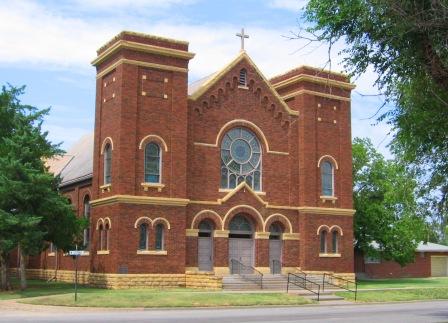
The history of Rush County is preserved in eight museums and a number of historic churches, buildings, and historic sites. We are also situated in the center of what is known as “Post Rock Country”, a geologic anomoly in central Kansas that is home to a variety of unique
limestone buildings as well as the unique Post Rock fenceposts that line the highways and backroads. A diverse ethnic history awaits you as you learn about the Volga Germans who first settled in northern Rush County and the Bohemian settlers who settled southeastern Rush County over a century and
a half ago to the “Irish for a Day” celebration every year in Rush County.
In the fall of 2022, Rush County was designated as part of a Post Rock Limestone Multi-Property Listing on the National Register of Historic Places due to the large number of historic Post Rock Limestone structures in the county.
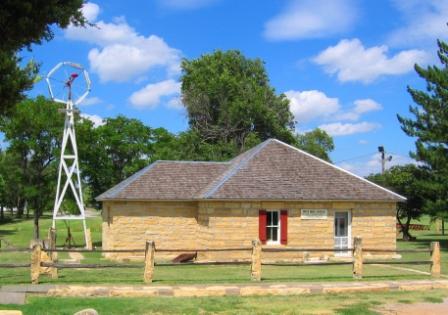
Post Rock Museum The Post Rock Museum is housed in a native stone house built with the same equipment, pioneer ingenuity, and stone it now preserves. The museum includes an authentic stone quarry re-creation and items depicting the history of the post rock unique to this region. The museum is operated by the Rush County Historical Society.
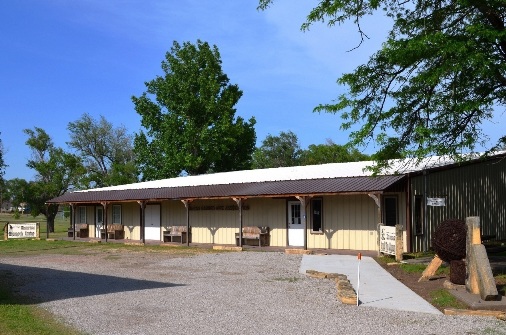
Kansas Barbed Wire Museum The Kansas Barbed Wire Museum illustrates the history and legend of the "Devil's Rope". On exhibit are over 2000 varieties of fencing wire; many manufactured between the years 1870 and 1890. Hundreds of antique fencing tools represent the inventiveness of pioneers. The museum also houses the headquarters of the Antique Barbed Wire Society including the Hagemeier Conference Room and Larry Greer Research Center.
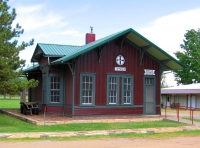
Rush County Historical Museum Housed in the original Timken Santa Fe Railroad depot, The Rush County Historical Museum displays artifacts of interest to the history of the area. Museum collections include medical equipment, photographs and scrapbooks, clothing and uniforms, and many pioneer and early settler household items. The museum is operated by the Rush County Historical Society.
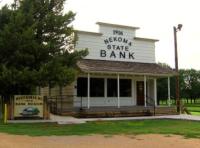
Nekoma Bank Museum Moved to the museum complex in LaCrosse from its original site in Nekoma in southwest Rush County, the original wood frame Nekoma State Bank building has been developed into a museum of rural banking and features a restored early 20th-century furnished bank lobby lobby, and collections of equipment and memorabilia from the early days of banking. The museum is operated by the Rush County Historical Society.

Pleasant Point School Museum Moved to the museum complex from its original site 6.5 miles south of Nekoma in southwest Rush County, the wood frame school is one of the last remaining in Rush County. The building contains most of its original furnishings along with artifacts of early 20th-century education. The museum, officially opened to the public in 2019, is operated by the Rush County Historical Society.

Rush County Courthouse The Rush County Courthouse was constructed in 1888 following a "tug-of-war" for the county seat. The Romanesque style building is constructed primarily of brick with native stone accents. Prominent features of the building include a circular tower on the southeast corner, a square tower on the northeast, native stone arches over the entrances and stained glass dormers. The building is now listed in the National Register of Historic Places. The interior main floor offices and the second floor courtroom and offices have been carefully restored with the aid of Preservation Trust Grants from the Kansas State Historical Society. Windows on the first and second floors have been restored and exterior brick has been repointed and stabilized. The building is handicap accessible and features the necessary modern amenities without damage to the structure's historical character. Learn more about the history of the Rush County Courthouse.
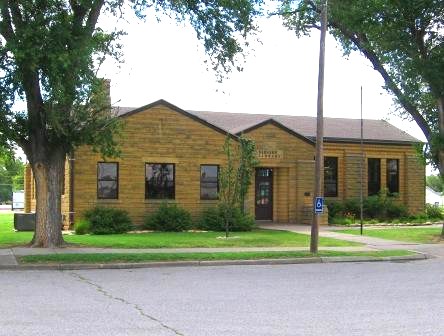
Barnard Library The Barnard Library is housed in a native limestone building located at 521 Elm Street in La Crosse. The building was constructed as a project of the Works Progress Administration, a program initiated by President Franklin D. Roosevelt during the 1930s to create jobs in a troubled economy. The Barnard Library is named in honor of Howard R. Barnard, one of the great educators in the history of America's small schools.
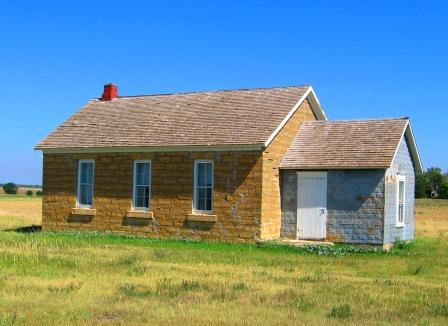
Bison Lone Star School George Ficken Jr. donated land one and one-half miles west of Bison for a German Methodist Episcopal Church and school. Construction began in 1878 with hand-hewn native stone donated by members of the church. It was the first German speaking Methodist Church in Rush County. Rev. C.G. Fritsche, the first resident pastor, cut a lone star on the east gable of the building in reverence to The Holy Land and its Lone Star, Our Lord, Jesus Christ. Lone Star was used as a church and school until the congregation built a new church one mile north in 1890. The building was sold to school district 34 (later 64) and classes were held at Lone Star School until 1947 when the district merged with Bison. The schoolhouse was most recently used as a clubhouse by the Sunshine Extension Homemakers Unit of Bison. Former students and members of the Bison community have donated time and money to help with maintenance and repairs. The interior features several pieces of original furnishings and original gas light fixtures. The building is listed on the National Register of Historic Places.
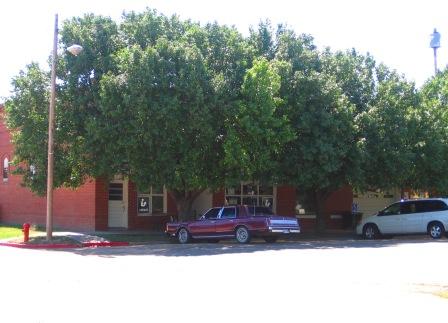
Bison Community Museum The Bison Community Museum is located in the Community Building on Main Street in Bison. Many of the contents were donated by area citizens and are retained by the museum as a public trust. The museum displays household items, tools, clothing and personal items used in the first half of the 20th century. Also displayed are artifacts that offer a glimpse into Bisons early history, including a large display of advertising memorabilia, calendars, and thermometers, that attest to the thriving business section once present in Bison. Photographs of early Bison, its residents and events describe the city and surrounding farm life as well as the devastation left by the 1912 tornado. Other items of interest include a small scale replica of a header barge, stone working tools used to cut limestone posts and a postcard collection from the turn of the century. The museum is open only on special occasions or by special request.
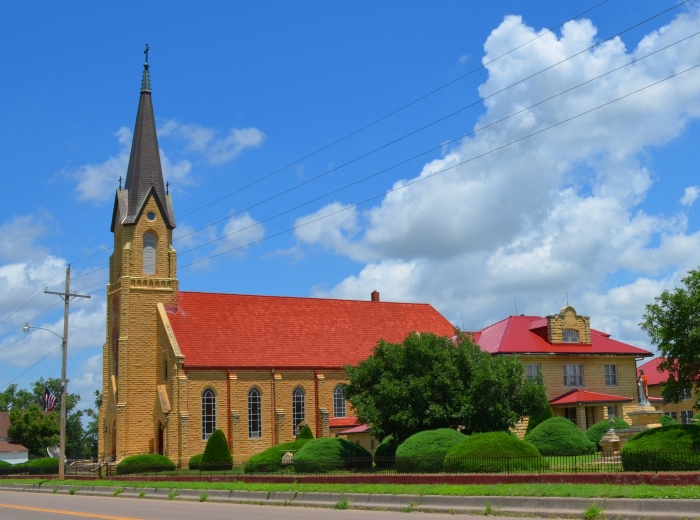
St. Joseph Kirche
At first, church services for Liebenthal residents were held in homes or in the open air (weather permitting) whenever an itinerate priest would visit the village. The first Roman Catholic church was completed in 1878. By the early 1900s, a larger church building was needed. German-born architect, Viktor Klutho, of St. Louis, Missouri drew the design for a new Gothic style church. From 1902 until 1905, the members of the parish worked to complete the building. Over two thousand loads of native “Fencepost limestone” were quarried from nearby hills, moved by wagon, cut, shaped, stacked and set to form the walls of this beautiful building. The stained glass windows were made by an Austrian/German artist.
Twice, fire destroyed all of the wood sections and the roof of the cathedral. It was rebuilt and rededicated in 1921 and 1961 but the interior walls and the altar are no longer as ornately fine as before the last fire. However, the original stone walls are those erected by the Liebenthal forefathers. St. Josephs Kirche stands as one of the most beautiful churches on the Kansas plains. Located near the church are the rectory and parocial school, both constructed of native stone quarried near the community. In 2014 artisans restored and repainted interior walls of the church.

St. Mary's McCracken Heritage Association The first St. Mary's Church building was constructed in 1886 southwest of McCracken. The original wood structure was replaced with a stone building on the same location in 1906. On July 7, 1922, work was begun on the basement and foundation of the present St. Mary's Catholic Church using stone from the old church. The building was completed in May of 1926. In 1997, following restructuring of the Liebenthal, McCracken, and Timken churches, Mass was no longer held on a regular basis in McCracken. Members of the parish formed the Saint Mary's McCracken Heritage Association in effort to preserve the beautiful building. Currently the building is used for special occasions and services.
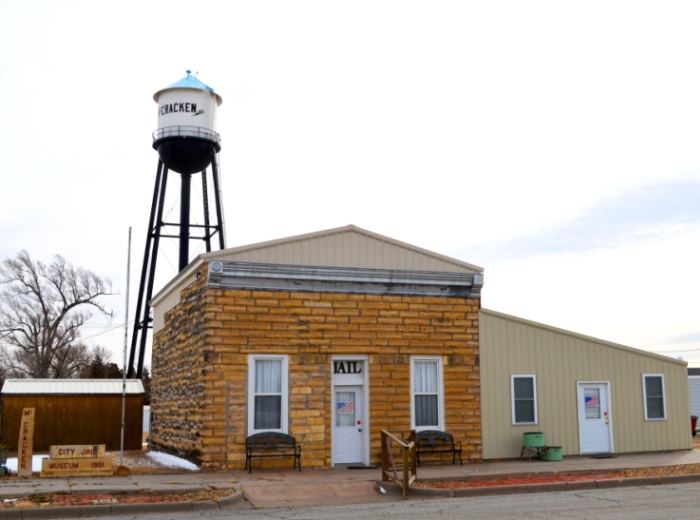
McCracken Historical Museum & Paper Moon Museum
Located in the former City Jail on Main Street in McCracken, the museum was dedicated on July 14, 2001. The native stone jail was originally opened in 1901. In addition to housing the jail, the building served as the McCracken City Hall and Fire Department. The museum displays numerous items relative to the history of McCracken as well as a display of the 1973 movie, "Paper Moon," filmed in and around McCracken. For more about McCracken, visit the McCracken Alumni webpage.
Recently, the museum board along with local volunteers constructed an addition to the museum to house their extensive collection of memorabilia from the 1973 motion picture Paper Moon, filmed in McCracken and in the communities surrounding.
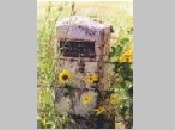
Fort Hays - Fort Dodge Trail / Hampton Cemetery
The community of Hampton, located along the Fort Hays - Fort Dodge military trail, was situated five miles east of McCracken. The community no longer exists, however, area citizens have worked to restore the cemetery.
Learn more about the trail from the Kansas State Historical Society.
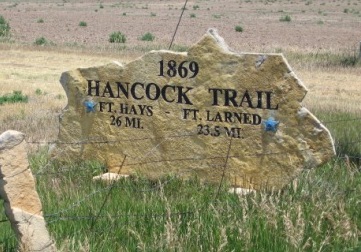
Fort Hays - Fort Larned Trail Also referred to as the General Winfield Scott Hancock Trail, it served as a road for hauling freight and mail between forts and outlaying encampments. The trail entered northern Rush County in Big Timber Township east of Highway 183, crossed Sand Creek east of LaCrosse into Section 3-18-18, crossed Walnut Creek in W2 NE4 25-18-18 and crossed into Pawnee County three-quarters of a mile west of Ash Valley.